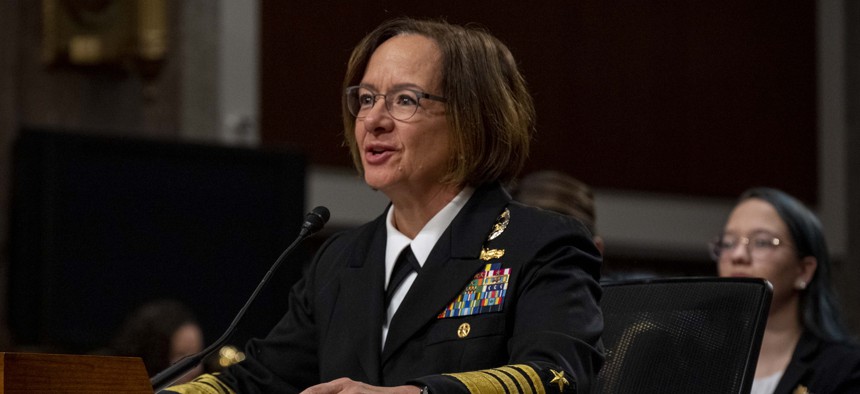
Vice Chief of Naval Operations Adm. Lisa Franchetti answers questions from members of the Senate Armed Services Committee during her confirmation hearing, Sep. 14, 2023. U.S. Navy / Chief Mass Communication Specialist Amanda R. Gray
CNO: US Navy is having a 1930s moment
Franchetti highlights “warfighting” and “warfighters” as key priorities.
The U.S. Navy’s surface fleet finds itself in a position not unlike the 1930s, when it needed new focus and energy to prepare for a potential war, the chief of naval operations said Tuesday.
“In the 1930s, constrained defense budgets following the Great Depression resulted in reduced construction, a shrinking shipbuilding industry, and a widening gap between the capability and capacity of our Navy and that of Imperial Japan. America in the 30s possessed a fleet that was too small and insufficiently resourced for war,” Adm. Lisa Franchetti said at the Surface Navy Association’s annual conference in Virginia.
Franchetti, who stepped into the Navy’s top job in November, recalled how her long-ago predecessors needed to boost production of new ships and develop new tactics to face a new adversary, the Japanese. Key to meeting that challenge: figuring out how to integrate air operations into fleet maneuvers. A handful of minds at the Naval War College helped turn the American naval fleet into a living laboratory for new concepts.
“They used information from key problems to simulate a whole naval campaign, hypothesize what a future war might look like against the Japanese and other potential adversaries. Those results directly informed a series of war plans that not only analyzed how to fight but what the fleet needed to look like to seize advantage at sea. The Navy would shift from a platform-centric strategy, which was centered on battleships, to one that saw the future as an integrated naval force on, under and above the seas,” she said.
That shift played a decisive role in the Navy’s ability to mount a campaign against the Japanese Navy.
“They increased manpower; they ramped up production based on a joint demand signal from the White House, Congress and the Navy historians will tell us that the peacetime efforts of the 1930s contributed 95% of the modern ships that were available to fight in the war,” the admiral said
The U.S. Navy today finds itself in a similar situation with a small window in which to rapidly innovate and strengthen the fleet.
“We have energized our working enterprise as a Naval War College and our warfighting development centers to empower leaders at all levels, to think differently about how we need to operate in uncertain complex and rapidly changing environments,” she said. The Navy will look to empower new generations of leaders to experiment with “new concepts and tactics in a series of fleet exercises and power problems.”
Franchetti said her top three priorities are warfighting, warfighters, and the foundation of both.
Navy officials acknowledge that they have a way to go to meet their own goals. Vice Adm. Brendan McLane, U.S. Naval Surface Forces commander, on Friday told reporters that the Navy cannot yet muster 75 fully mission-capable ships on any given day. (They are closer to 60.)
McLane also acknowledged the current situation in the Red Sea is less than ideal. The U.S. Navy has been very successful shooting down the drones and rockets fired by Houthi and other militia forces. But the Standard missiles they often use are is far more expensive than their targets. He said has highlighted a long-running inability to turn promising prototypes into deployed weapons—for example, lasers and other directed energy weapons.
“You know, when I was in Bahrain 10 years ago, the [USS Ponce] had a laser on it. And we're 10 years down the road and we still don't have something that we can field I mean. I find that frustrating. And I really want to put a lot of effort into accelerating that because that gives you so much when it comes to magazine capacity and, and speed and distance.”
But McLane said that the Navy is already putting lessons from Red Sea deployments to use, revamping how it deals with emerging problems like large volumes of cheap drones.
“We have our warfare tactics instructors involved in analyzing the data that we're getting…from the tapes on the [USS Carney] and the other ships and we're looking very closely at the profiles and what we have to do when it comes to radar tuning. And what we have to do when it comes to setting up our weapons systems on the ship to make sure that we have maximum defensive capability at all time.”
NEXT STORY: How Space Force is raising its cyber defenses




